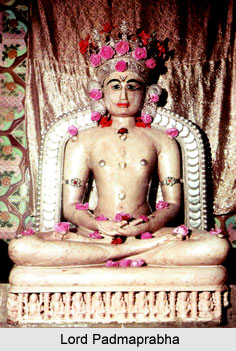 Shri Laxmani Teerth located in Madhya Pradesh is a Jain pilgrimage centre. The teerth kshetra is located at Kundalpur village at a distance of 3 kilometers from Nalanda. The temple is dedicated to Lord Padmaprabha, the sixth Jain Tirthankara.
Shri Laxmani Teerth located in Madhya Pradesh is a Jain pilgrimage centre. The teerth kshetra is located at Kundalpur village at a distance of 3 kilometers from Nalanda. The temple is dedicated to Lord Padmaprabha, the sixth Jain Tirthankara.
History of Shri Laxmani Teerth
According to history Shri Laxmani Teerth dates back to the ancient period. It is believed that this kshetra is almost 2000 years old. Earlier in the 16th century it was a rich and prosperous city. Nalanda and Kundalpur in ancient times were suburbs of Rajgiri. Indrabhuti, Agnibhuti and Vayubhuti were the three of the eleven Ganadhars of Lord Mahavira. They were the three brothers born here. Nalanda served as the great centre of Buddhist studies. There was a University, too. As per reference in the ancient times there were many Jain temple located here. However, they are now all ruined. The teeth place has been visited by Lord Mahavira several times. He has delivered his religious sermons to many devotees here. In Vikram Savant Era 1427 there were 2000 Shravakas who resided in this place. The last Jirnidhhar was done in Vikram Savant Era 1994. The Pratistha was done by learned Acharya Shri Vijay Yatindrasuriswarji. This place is thus regarded as very sacred and holy. The idol of Lord Padmaprabha is believed to possess miraculous powers. Devotees from far off places visit the temple to offer their prayers. It is believed that if prayed with all devotion the Lord fulfils the wishes of the pilgrims. The idol of Lord Padmaprabha is believed to possess miraculous powers. Devotees from far off places visit the temple to offer their prayers. It is believed that if prayed with all devotion the Lord fulfils the wishes of the pilgrims.
Temple of Shri Laxmani Teerth
The temple of Shri Laxmani Teerth houses the idol of Lord Padmaprabha. The temple has been magnificently decorated with intricate artistic designs. The creative temple work boast about the skills of the craftsmen. The idol of the Lord is almost 25 cm in height and is black in colour. It is seated in a padmasana posture. The idol has been beautifully carved from a single stone and looks very appealing. The smiling face of the Lord looks very calm and serene. There is an assembly hall in this temple that has been attractively decorated. The three pinnacles of the temple adorn its beauty. The walls of the temple are decorated with 137 artistic and multicolour paintings of the life of King Shripal. These are worth seeing and look spectacular. Some of the pillars constructed here look like Kirtistambhs on account of their artistic beauty. Apart from this temple there is a Digambara temple. This is also a Trisikhar Temple here. The Sabha Mandap of the temple is very spacious and adorns its beauty. Another Guru Mandir of Acharya Shri Rajendrasurriswarji is located in the vicinity of the temple.
The Temple of Shri Laxmani Teerth organises many annual gatherings and functions. A fair is held on Kartika and Chaitra Punam. There are provisions for dharamshalas or rest houses for the pilgrims. These are well equipped with all modern facilities. Apart from this there are Upashrays, an Ayambilshala and a Jnanabhandar. The temple is enclosed by scenic beauty that mesmerizes and fascinates the pilgrims. The calm and tranquil environment and the surrounding greenery make it a suitable place for religious activities. The kshetra is well connected to road, rail and air. Bus and taxies are easily available for the kshetra. The nearest bus stop is located at Ali Rajpur. The nearest railway station is located at Dahod at distance of about 80 Km. The nearest airport is located at Vadodara at a distance of 153 Km. and Indore at 225 Km from here.




















